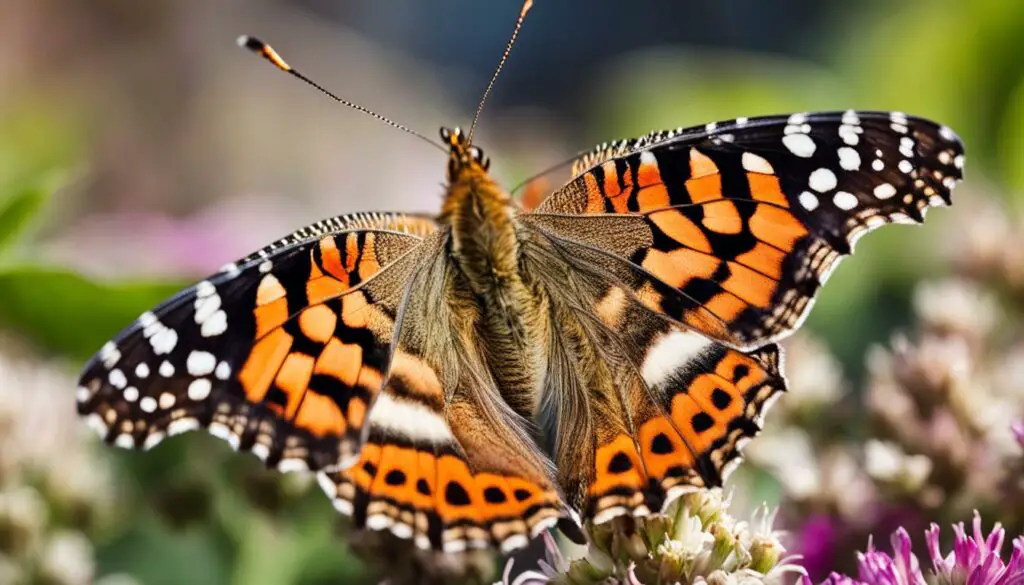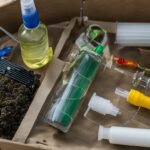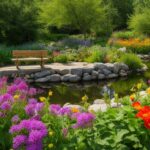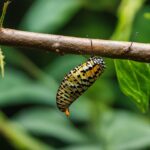The painted lady butterfly, also known as Vanessa cardui, is a widely distributed and popular species to rear at home. This comprehensive guide provides step-by-step instructions on how to successfully raise painted lady butterflies from eggs to adults. Whether you’re a beginner or an experienced butterfly enthusiast, this guide will help you become an expert in painted lady rearing.
Key Takeaways:
- Follow this detailed guide for comprehensive painted lady rearing instructions.
- Order live butterfly larvae from a reliable source and gather necessary supplies.
- Transfer larvae to individual cups with food and monitor their growth.
- Provide a suitable environment for chrysalis formation and care.
- Care for adult butterflies by offering nectar sources and maintaining a clean environment.
Getting Started: Ordering Painted Lady Larvae and Supplies
To embark on your painted lady rearing journey, the first step is to order live butterfly larvae from a trusted source. Companies such as Carolina Biological or Insect Lore offer high-quality painted lady larvae for sale. Ensure that you order the appropriate number of larvae based on your rearing goals and available resources.
Along with the live larvae, you will need to gather some essential supplies to create a suitable habitat for your growing butterflies. These supplies include prepared food, a mesh butterfly rearing cage, a small paintbrush or cotton swab for handling the larvae, condiment cups with lids for housing the larvae, and a misting spray bottle for maintaining humidity. Having all these supplies ready before the arrival of your larvae will ensure a smooth and successful rearing process.
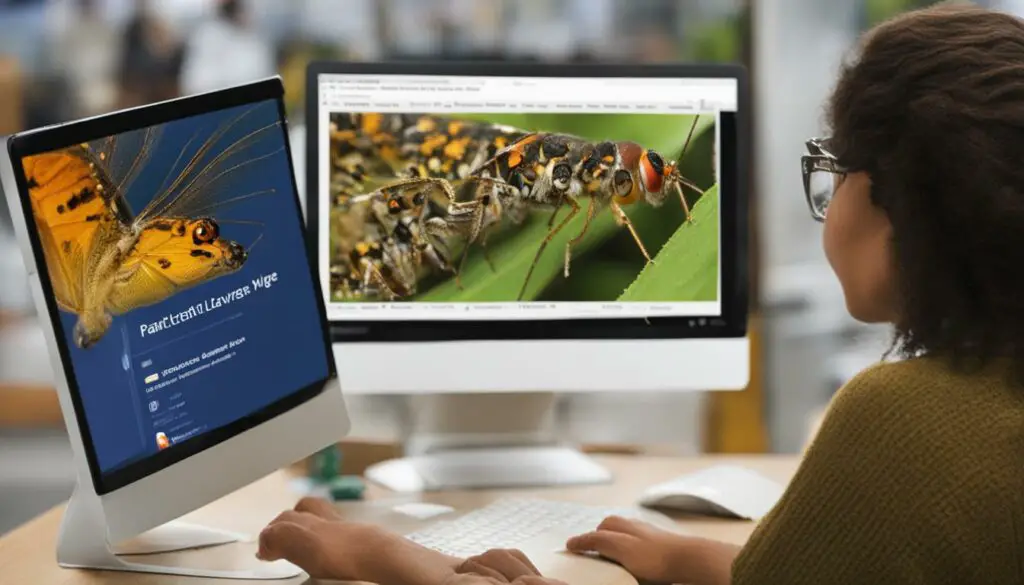
Table: Recommended Supplies for Painted Lady Rearing
| Supplies | Description |
|---|---|
| Prepared Food | A specialized diet formulated for butterfly larvae, such as a powdered artificial diet or fresh host plant leaves. |
| Mesh Butterfly Rearing Cage | A well-ventilated cage with a fine mesh to prevent the escape of caterpillars and provide ample space for their growth. |
| Handling Tool | A small paintbrush or cotton swab to gently move and handle the delicate larvae without causing harm. |
| Condiment Cups with Lids | Individual cups to house each larva, providing a controlled environment for feeding and molting. |
| Misting Spray Bottle | A spray bottle filled with water to maintain humidity levels within the rearing cage. |
By ensuring you have the necessary supplies and live larvae from a reliable source, you are ready to embark on an exciting journey of painted lady rearing.
Rearing Painted Lady Larvae
Once your painted lady larvae arrive, it’s time to start the exciting process of raising them. Here are some important steps to follow:
1. Transfer the Larvae
When you receive your larvae, carefully transfer each one to an individual cup with food. Make sure to handle them gently using a small paintbrush or cotton swab. The larvae will need fresh food regularly, so keep an eye on their food supply and replace it as needed.
2. Monitor Growth and Development
Painted lady larvae go through several molting stages as they grow. Each time they molt, they shed their old skin and reveal a larger, new skin underneath. It’s important to monitor their growth and development, as this will give you an idea of their progress. You may notice that the larvae become larger and more active with each molt.
3. The Chrysalis Stage
After around 5-10 days of feeding and growing, the painted lady larvae will enter the chrysalis stage. During this time, they will attach themselves to a surface and undergo the incredible transformation into butterflies. The chrysalis will appear as a small, hanging structure, and it’s essential not to disturb or move it during this stage.
4. Patience is Key
While waiting for the chrysalides to develop into butterflies, it’s important to be patient. This stage can take anywhere from a few days to a couple of weeks, depending on environmental conditions. Resist the temptation to handle or disturb the chrysalides, as this can disrupt the delicate process of metamorphosis.
Rearing painted lady larvae is a fascinating and rewarding experience. By following these steps and providing proper care, you will witness the magical transformation of caterpillars into beautiful butterflies.
Chrysalis Care
Once the painted lady larvae have formed their chrysalides, it’s important to give them proper care and attention during this delicate stage. Chrysalis formation is a crucial part of the butterfly life cycle, and providing the right conditions can greatly impact the successful emergence of healthy adult butterflies.
Transferring Chrysalides
When the chrysalides are fully hardened, it’s time to transfer them to a larger butterfly cage. Carefully detach the chrysalides from their original surfaces using a soft brush or tweezers, being cautious not to damage them. Attach the chrysalides to the mesh walls of the butterfly cage using a small piece of thread or dental floss. Ensure that they are securely fastened and have enough space to allow the emerging butterflies to stretch their wings.
Butterfly Pupa Care
During the chrysalis stage, it’s important to maintain optimal humidity levels to support proper development. Mist the chrysalides regularly with water using a spray bottle to provide a humid environment. This helps ensure that the chrysalides do not dry out, which could lead to deformities in the emerging butterflies. Be cautious not to overspray and create excessive moisture, as this can promote the growth of bacteria or mold.
Table:
| Chrysalis Care Tips | Benefits |
|---|---|
| Transfer chrysalides to a larger butterfly cage | Allows space for butterflies to stretch wings |
| Mist chrysalides regularly with water | Maintains optimal humidity levels |
| Avoid excessive moisture | Prevents bacterial or mold growth |
By following these chrysalis care tips, you can ensure the successful development and emergence of your painted lady butterflies. It’s a fascinating stage to observe, as the butterflies transform from pupae to vibrant adults. With patience and proper care, you’ll soon witness the beauty of these winged creatures as they make their remarkable journey.
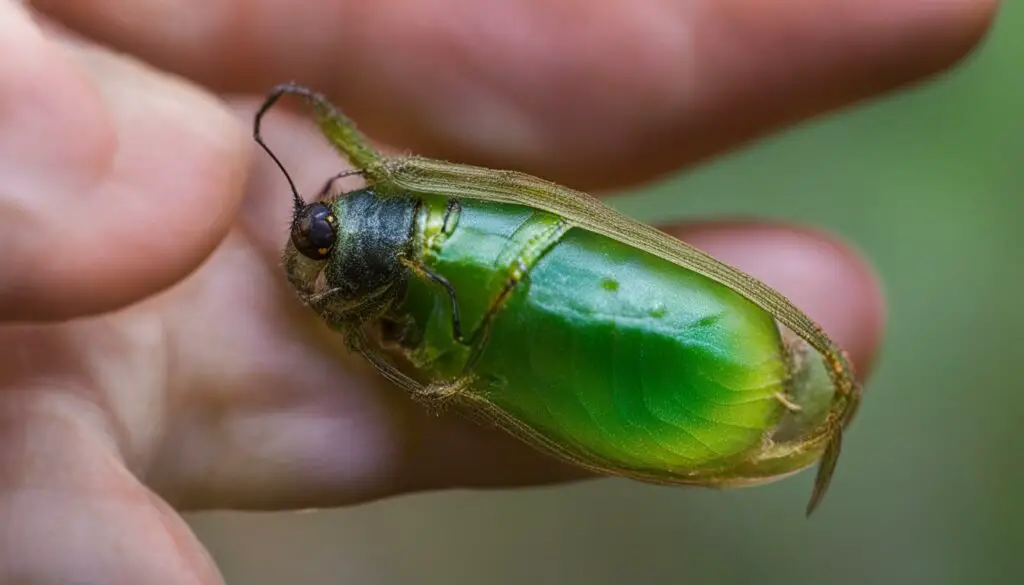
Caring for Adult Butterflies
Now that your painted lady butterflies have emerged from their chrysalides, it’s important to provide them with the necessary care to ensure their health and happiness. Adult butterflies have specific needs when it comes to food and environment, so here are some tips on how to properly care for them:
Butterfly Nectar Sources
To keep your adult painted lady butterflies nourished, it’s essential to provide them with ample nectar sources. This will help sustain their energy levels and support their overall wellbeing. Some popular nectar sources for butterflies include:
- Flowering plants such as zinnias, marigolds, and butterfly bush
- Native wildflowers that attract butterflies, such as milkweed and coneflower
- Sugar-water solution mixed in a shallow dish or small container
- Fresh fruit slices, such as oranges or watermelon
Ensure that the nectar sources are easily accessible to the butterflies by placing them in shallow dishes or by using feeders with special features designed for butterflies. This will help them easily feed and replenish their energy reserves.
Properly feeding your butterflies is crucial for their survival and overall health. Make sure to regularly clean and refill the nectar sources to prevent contamination and ensure a fresh, healthy food supply.
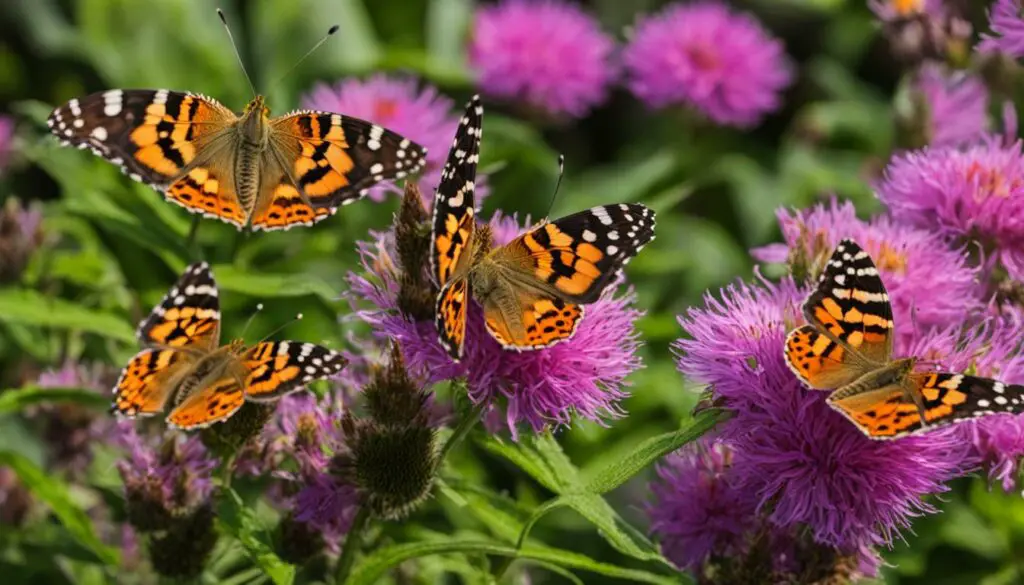
If you want to attract a variety of butterfly species to your garden, consider planting a diverse range of nectar plants. This will not only provide food for the adult painted lady butterflies but also attract other beautiful species, adding color and life to your outdoor space.
| Nectar Source | Benefits |
|---|---|
| Zinnias | Colorful flowers that attract a wide variety of butterfly species |
| Marigolds | Strong scent that appeals to butterflies; easy to grow and maintain |
| Butterfly Bush | Produces abundant nectar and is a favorite of many butterfly species |
| Milkweed | Host plant for monarch butterflies and a vital source of nectar |
| Coneflower | Attracts butterflies with its vibrant flowers and rich nectar |
| Sugar-water solution | A simple and effective way to offer nectar to butterflies |
| Fresh fruit slices | Provides a natural and nutritious alternative to nectar |
Observing and Enjoying the Butterflies
Observing painted lady butterflies is a delightful and educational experience that allows you to witness the incredible beauty and behavior of these graceful creatures. Whether you’re a nature enthusiast, a curious learner, or simply enjoy the wonders of the natural world, spending time watching butterflies can bring joy and tranquility to your day.
One of the best ways to observe painted lady butterflies is to create a butterfly-friendly environment in your own backyard or garden. Planting nectar-rich flowers such as zinnias, marigolds, and butterfly bushes will attract these beautiful insects, providing you with an up-close view of their feeding habits and interactions. Find a comfortable spot to sit or relax nearby, and patiently watch as the butterflies flutter from flower to flower, delicately sipping nectar with their long, slender proboscis.
Another way to enjoy observing painted lady butterflies is to visit butterfly gardens or natural reserves that house these magnificent creatures. These designated areas typically provide a variety of native plants and flowers that attract butterflies, creating a vibrant and captivating environment. As you wander through these gardens, take note of the different species of butterflies you encounter, their unique wing patterns, and their fascinating behaviors.
When observing butterflies, it’s important to remember that they are delicate creatures. Avoid touching or handling them, as this can cause damage to their fragile wings. Instead, use binoculars or a camera with a zoom lens to get a closer look at their intricate patterns and vibrant colors. Capture their beauty through photographs or keep a nature journal to document your observations and create lasting memories.
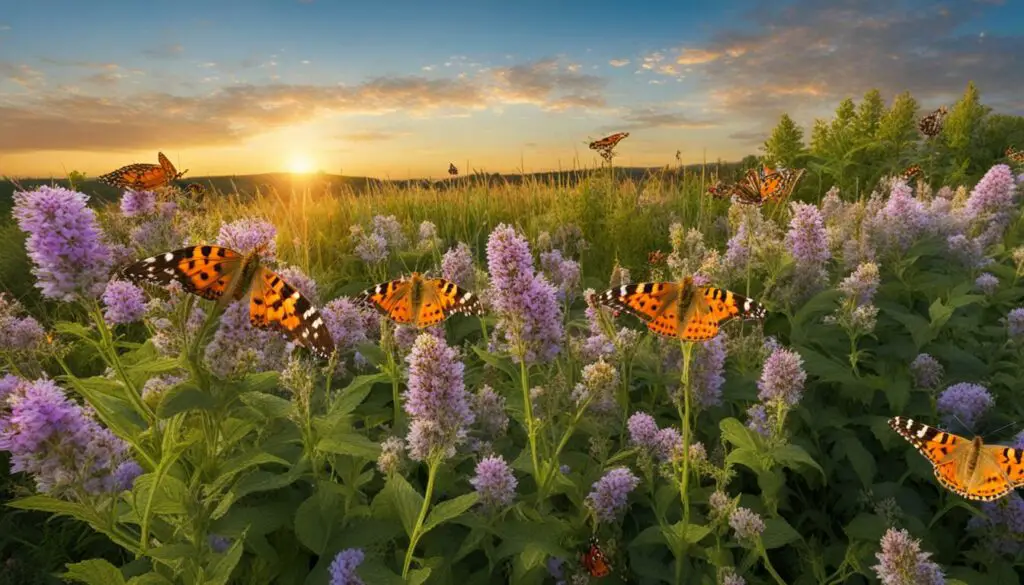
Butterfly Watching Tips:
- Choose a sunny, calm day for optimal butterfly activity.
- Wear light-colored clothing to attract butterflies.
- Move slowly and avoid sudden movements to avoid startling the butterflies.
- Bring a field guide or use a butterfly identification app to help you identify different species.
- Consider providing water sources, such as shallow dishes with wet sand or pebbles, for the butterflies to drink from.
- Release butterflies responsibly after observing them, allowing them to continue their natural life cycle.
Releasing Butterflies:
After raising painted lady butterflies from eggs to adults, you have the option to release them into the wild. Releasing butterflies can be a symbolic act of letting go and allowing these beautiful creatures to fulfill their purpose in nature. Choose a sunny, windless day for the release, as butterflies prefer warm and calm conditions. Open the butterfly cage or container in an open space, preferably near flowering plants, and give the butterflies time to acclimate to their surroundings. Watch in awe as they take flight, spreading their vibrant wings and gracefully soaring into the sky. It’s a truly magical experience that connects us to the wonders of nature.
Classroom Activities with Painted Lady Butterflies
The journey of rearing painted lady butterflies extends beyond the joy of witnessing their transformation. It offers a unique opportunity to engage students in educational activities centered around the butterfly life cycle. These activities not only provide hands-on learning experiences but also foster curiosity, critical thinking, and a deeper appreciation for the natural world.
Butterfly Life Cycle Lessons
One of the most impactful ways to teach students about the life cycle of butterflies is through observation. Set up a butterfly rearing station in the classroom, complete with caterpillars, chrysalides, and emerging butterflies. Encourage students to observe and document the different stages of the life cycle, noting the physical changes and behaviors exhibited by the butterflies. This first-hand experience allows students to develop a deeper understanding and connection to the concepts of metamorphosis and growth.
Create a butterfly life cycle display in the classroom using visual aids such as charts, diagrams, or even a wall mural. This visually engaging representation helps students visualize and comprehend the various stages of the butterfly life cycle, from egg to larva to pupa to adult. Encourage students to present their findings and observations to the class, fostering communication and presentation skills.
Educational Activities
Engage students in interactive activities that further explore the world of butterflies. Provide butterfly-themed coloring sheets, puzzles, or quizzes that help reinforce their knowledge of the butterfly life cycle and related concepts. Encourage students to create butterfly-themed art projects, such as drawing or painting their own butterfly designs or constructing butterfly models using craft materials.
Additionally, students can participate in citizen science initiatives focused on butterflies. These initiatives encourage students to collect and report data on butterfly sightings, behavior, or migration patterns. By contributing to ongoing research projects, students become active participants in scientific inquiry and gain a deeper understanding of the importance of data collection and analysis in scientific studies.
Teaching with Butterflies
Integrate painted lady butterflies into various subjects and disciplines to create cross-curricular learning opportunities. Incorporate butterfly-themed literature into English language arts lessons, exploring books and poems that celebrate the beauty and symbolism of butterflies. In mathematics, students can analyze and graph data related to the growth and development of painted lady butterflies, fostering mathematical skills and data interpretation.
Finally, encourage students to share their newfound knowledge and fascination with painted lady butterflies by organizing a butterfly-themed exhibition or presentation for the school community or parents. This allows students to become educators themselves, showcasing their learning and inspiring others to appreciate and protect these delicate creatures.
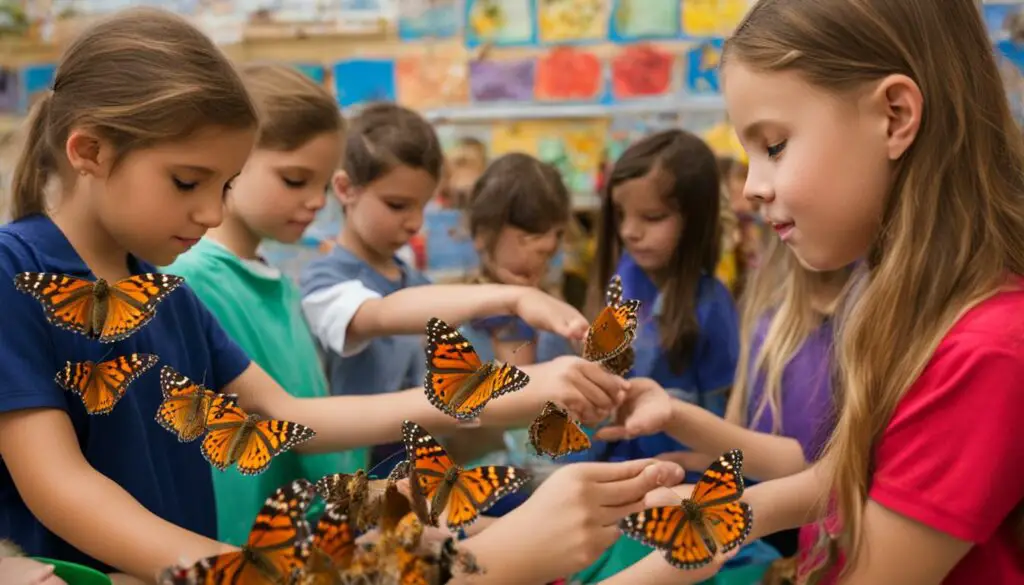
Table: Classroom Activity Ideas
| Activity | Description |
|---|---|
| Butterfly Observation Journal | Encourage students to maintain a journal documenting the various stages of butterfly development and their observations. They can record behaviors, physical changes, and personal reflections. |
| Butterfly Life Cycle Display | Create a visual representation of the butterfly life cycle using charts, diagrams, or artwork. Display it in the classroom to reinforce learning and spark conversations. |
| Citizen Science Project | Engage students in citizen science initiatives focused on butterflies. They can collect data on butterfly sightings, behavior, or migration patterns and contribute to ongoing research projects. |
| Butterfly-Themed Art Projects | Encourage students to express their creativity through butterfly-themed art projects. They can create butterfly drawings, paintings, or models using a variety of materials. |
| Cross-Curricular Integration | Integrate painted lady butterflies into various subjects and disciplines. Explore butterfly-themed literature in English language arts or analyze growth data in mathematics. |
| Butterfly Exhibition or Presentation | Organize a butterfly-themed exhibition or presentation to showcase students’ learning. This allows them to become educators, sharing their knowledge and inspiring others. |
Tips for Successful Painted Lady Rearing
Rearing painted lady butterflies can be a fascinating and rewarding experience. To ensure success in raising healthy and thriving butterflies, here are some important tips:
1. Seek Guidance and Prior Experience
If you’re new to butterfly rearing, it’s beneficial to seek guidance from experienced butterfly enthusiasts or join online communities dedicated to butterfly rearing. Learning from others’ experiences can provide valuable insights and tips to help you navigate the process successfully.
2. Maintain Optimal Temperature and Humidity
Painted lady butterflies thrive in temperatures between 70-80°F (21-27°C) and require a humidity level of around 60-80%. It’s crucial to monitor and maintain these conditions to ensure the healthy development of larvae, chrysalides, and adult butterflies. Using a thermometer and hygrometer can help you keep track of temperature and humidity levels accurately.
3. Provide Fresh and Appropriate Food
Throughout their lifecycle, painted lady butterflies require a variety of host plants and nectar sources for food. Offer a selection of suitable plants, such as thistle, hollyhock, and mallow, to cater to their feeding needs. Ensure the food is fresh and free from any pesticides or harmful chemicals that could harm the butterflies.
4. Handle Larvae and Butterflies with Care
When handling painted lady larvae or adult butterflies, it’s crucial to be gentle and careful. Avoid touching their delicate wings as this can damage them and hinder their ability to fly. Use a small paintbrush or cotton swab for handling larvae and support the butterflies’ bodies when transferring or releasing them. Always wash your hands before and after handling to prevent the spread of any harmful bacteria.
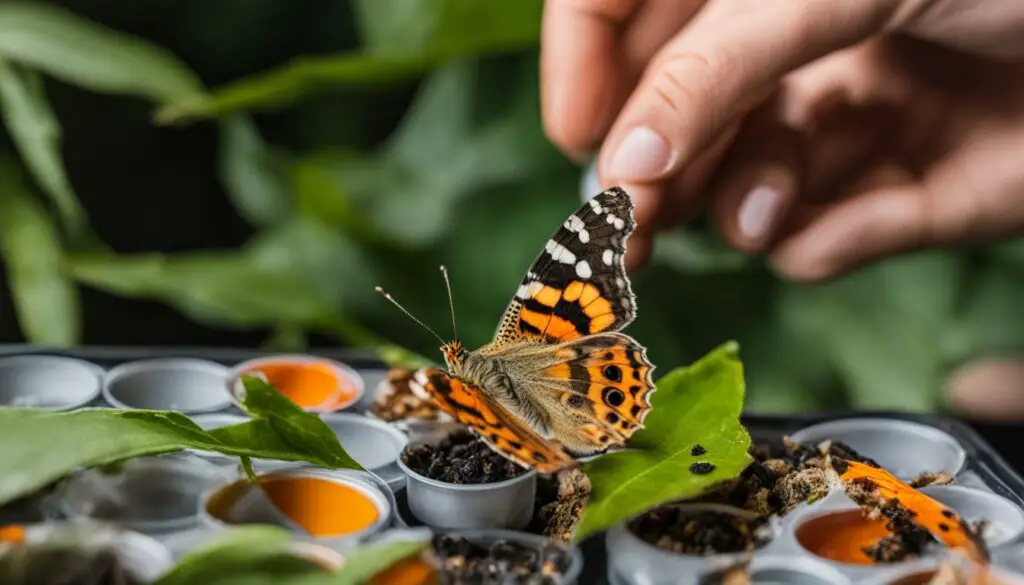
By following these tips, you can create a conducive environment for the successful rearing of painted lady butterflies. Enjoy the beauty and wonder of these remarkable creatures as they transform from tiny eggs to magnificent butterflies!
Painted Lady Butterfly Facts and Characteristics
The painted lady butterfly, scientifically known as Vanessa cardui, is a fascinating species with unique characteristics. Here are some interesting facts about these beautiful butterflies:
- The painted lady butterfly is the most widely distributed butterfly species in the world, found on every continent except Antarctica.
- They are commonly seen in various habitats including gardens, meadows, fields, and even urban areas.
- Painted ladies have a wingspan of about 2 to 2.7 inches (5 to 7 centimeters), with vibrant orange and black markings.
- These butterflies are known for their long-distance migrations, with some individual butterflies covering up to 100 miles per day.
- They have a preference for host plants such as thistle, hollyhock, mallow, and other members of the Asteraceae and Malvaceae families.
The painted lady butterfly undergoes a complete metamorphosis, starting as an egg and transforming into a larva or caterpillar. After going through the chrysalis stage, they emerge as beautiful adult butterflies.
During their lifecycle, painted lady butterflies play an essential role in pollination. As they feed on nectar from flowers, they inadvertently transfer pollen from one plant to another, aiding in plant reproduction.
| Painted Lady Butterfly Facts | Characteristics |
|---|---|
| Scientific Name | Vanessa cardui |
| Wingspan | 2 to 2.7 inches (5 to 7 centimeters) |
| Habitat | Gardens, meadows, fields, urban areas |
| Migrations | Long-distance, up to 100 miles per day |
| Host Plants | Thistle, hollyhock, mallow, Asteraceae, Malvaceae |
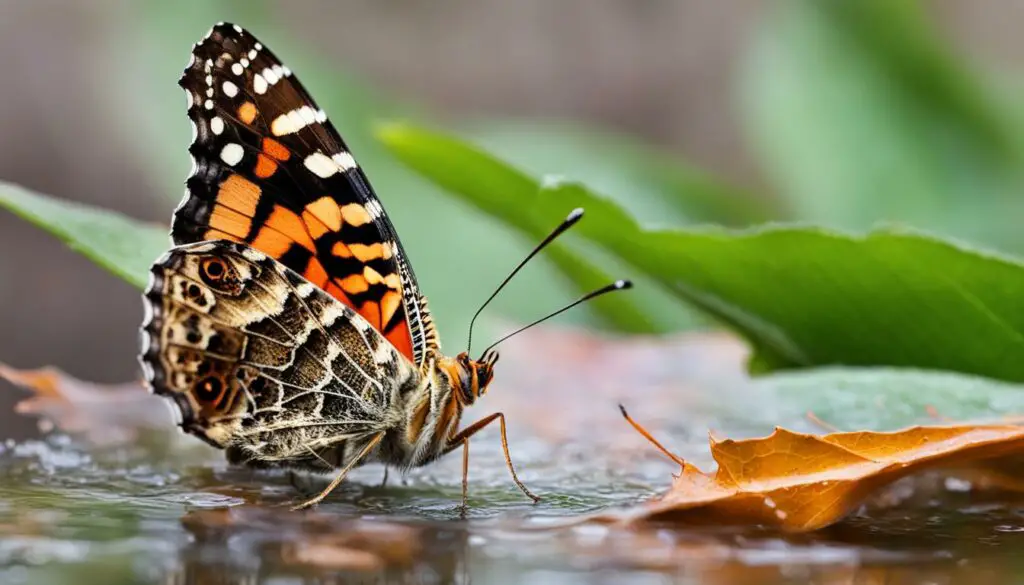
Learning about the facts and characteristics of painted lady butterflies can deepen our appreciation for these incredible creatures and inspire us to protect their habitats. By understanding their life cycle and role in pollination, we can contribute to their survival and the preservation of our natural environment.
Butterfly Conservation and Environmental Awareness
Conserving butterfly populations and protecting their habitats is crucial for maintaining biodiversity and promoting environmental health. Butterflies play a vital role as pollinators, contributing to the reproduction of many plant species. They serve as indicators of ecosystem health and are an integral part of the food chain for various wildlife species. By engaging in butterfly conservation efforts, we can contribute to the preservation of these delicate creatures and the ecosystems they inhabit.
One way to support butterfly conservation is by creating butterfly-friendly habitats in our own backyard or community spaces. Planting native flowers and host plants provides essential food sources for butterflies at various stages of their life cycle. These habitats also offer shelter, breeding sites, and nectar sources for other beneficial insects and wildlife. By encouraging the presence of butterflies, we can foster a thriving ecosystem and help maintain the balance of nature.
Environmental education is another key aspect of butterfly conservation. By increasing awareness and knowledge about butterflies and their habitats, we can inspire individuals to take action. Schools, community organizations, and nature centers can organize educational programs, workshops, and guided field trips to teach people about the importance of butterflies. Through hands-on activities and interactive learning, we can instill a sense of stewardship and empower individuals to make a positive impact on their environment.
| Ways to Support Butterfly Conservation: |
|---|
| Create butterfly-friendly habitats: Plant native flowers and host plants that provide food and shelter for butterflies. |
| Educate others: Organize educational programs and workshops to raise awareness about butterflies and their conservation needs. |
| Participate in citizen science initiatives: Contribute to butterfly monitoring projects and help collect data on population trends and distribution. |
| Preserve natural habitats: Support efforts to protect and restore butterfly habitats such as meadows, prairies, and wetlands. |
By taking these actions, we can promote butterfly conservation and contribute to the preservation of these graceful creatures. Every individual effort counts, and together, we can make a difference in ensuring a future where butterflies continue to brighten our landscapes and inspire us with their beauty.
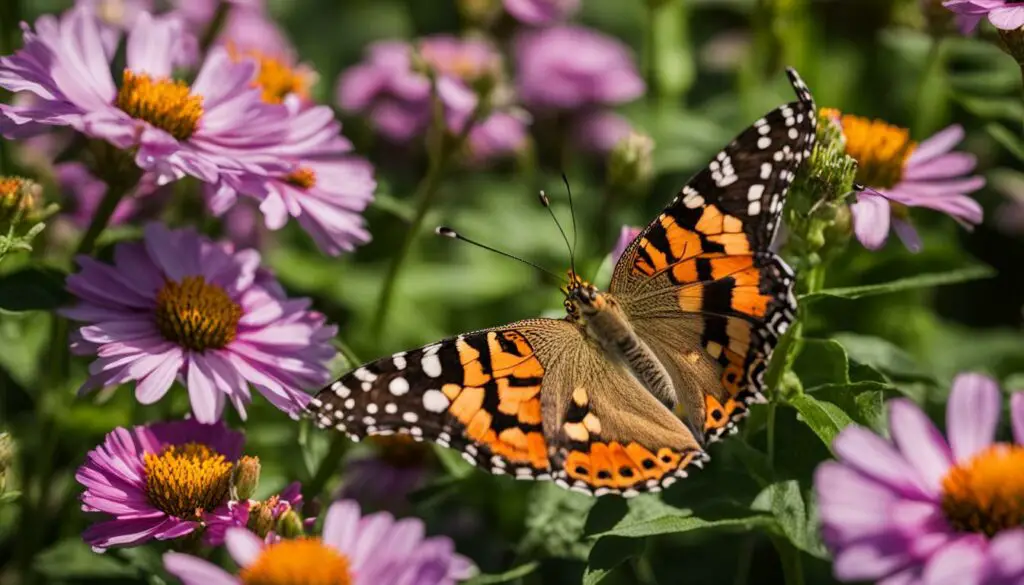
Painted Lady Butterfly Resources and Videos
As you embark on the journey of rearing painted lady butterflies, it’s essential to have access to educational resources and videos that can enhance your understanding of these fascinating creatures. Whether you’re a teacher looking for classroom materials or an enthusiast seeking further knowledge, there are plenty of valuable resources available.
One excellent resource is the Butterfly Conservation website, which offers a wealth of information on painted lady butterflies and other species. You’ll find detailed descriptions of their life cycle, habitat requirements, and conservation efforts. The website also provides downloadable educational materials, including worksheets and activity guides, to engage learners of all ages.
If you prefer videos, The Painted Lady Butterfly video series by the Smithsonian National Museum of Natural History is a fantastic choice. This series explores various aspects of painted lady butterflies, from their remarkable migration patterns to their intricate wing patterns. The videos showcase the butterflies in their natural habitats, providing a visual feast for butterfly enthusiasts.
For a more comprehensive understanding of painted lady butterflies, consider exploring Butterflies and Moths of North America (BAMONA). This citizen science project allows individuals to contribute their butterfly observations, helping to gather valuable data on butterfly populations. The website also features an extensive photo gallery, identification tools, and species profiles, making it an invaluable resource for butterfly enthusiasts.
| Resource | Description |
|---|---|
| Butterfly Conservation | A comprehensive website offering information on painted lady butterflies and other species, along with downloadable educational materials. |
| The Painted Lady Butterfly | A video series by the Smithsonian National Museum of Natural History, providing a closer look at painted lady butterflies. |
| Butterflies and Moths of North America (BAMONA) | A citizen science project that allows individuals to contribute butterfly observations and provides a wealth of information on various butterfly species. |
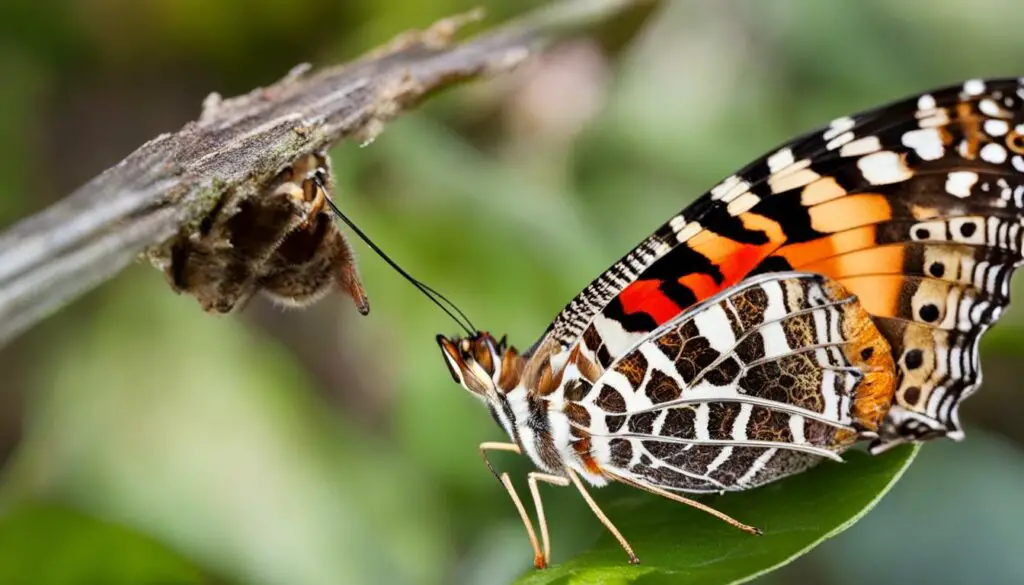
Key Takeaways:
- Butterfly Conservation offers valuable information and downloadable materials for educators and enthusiasts.
- The Painted Lady Butterfly video series provides a visual exploration of painted lady butterflies.
- Butterflies and Moths of North America (BAMONA) is a citizen science project with a wealth of species information and observation opportunities.
By utilizing these educational resources and videos, you can deepen your knowledge of painted lady butterflies and enhance your rearing experience. Whether you’re sharing this information with students, fellow enthusiasts, or simply expanding your own understanding, these resources provide a window into the captivating world of painted lady butterflies.
Interactive Butterfly Journals and Activities
Engaging students in interactive butterfly journals and activities is a wonderful way to enhance their learning experience and foster a deeper understanding of the butterfly life cycle. By encouraging students to observe, record, and reflect on the rearing process, they can develop essential scientific inquiry skills and gain a greater appreciation for the wonders of nature.
A butterfly journal provides a platform for students to document their observations, record growth stages, and reflect on the changes they witness. They can write about the caterpillar’s transformation into a chrysalis, document the emergence of the butterfly, and note any behaviors or patterns they observe. This interactive learning experience allows students to actively participate in the life cycle of a butterfly and develop their scientific communication skills.
To further engage students, a variety of butterfly life cycle activities can be incorporated into the classroom. These activities can include coloring sheets depicting different stages of the butterfly’s development, quizzes to test students’ knowledge, and games that reinforce the concepts learned. By making learning fun and interactive, students are more likely to retain information and develop a lifelong love for science and nature.
| Benefits of Interactive Butterfly Journals and Activities |
|---|
|
“Interactive butterfly journals and activities provide students with a hands-on approach to learning about the life cycle of butterflies. By actively participating in the rearing process and recording their observations, students develop a deeper understanding of the concepts and gain valuable scientific skills.” – Educator, Sarah Johnson
Whether in a classroom or at home, interactive butterfly journals and activities offer a unique opportunity for students to explore the world of butterflies and engage in meaningful, interactive learning. Through these experiences, students not only gain knowledge about the butterfly life cycle but also develop important skills that extend beyond the classroom. By fostering a love for science and nature, we can inspire the next generation of environmental stewards and butterfly enthusiasts.
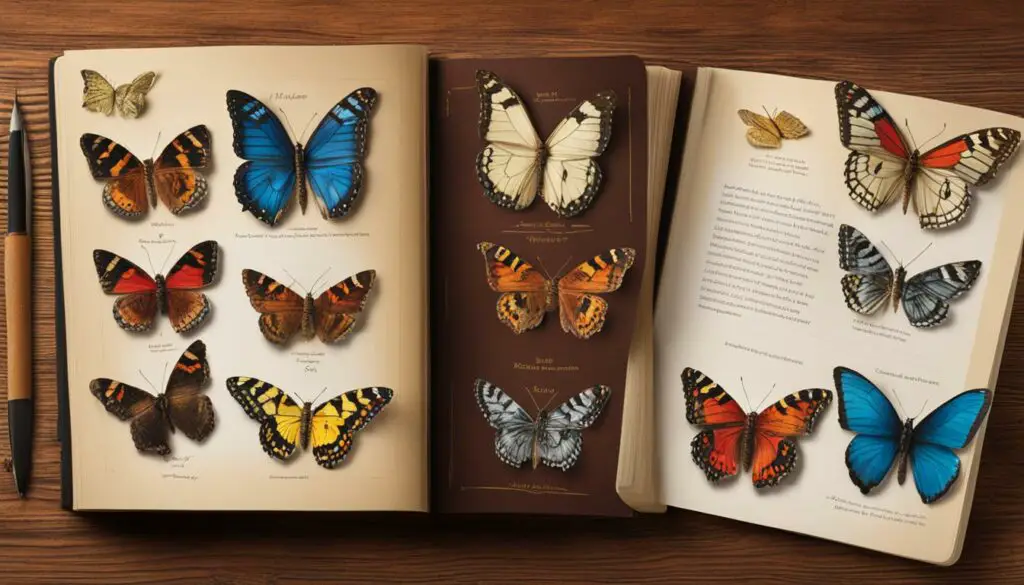
Conclusion
In conclusion, rearing painted lady butterflies is a rewarding and educational endeavor that allows me to witness nature’s incredible transformation. Following the step-by-step instructions and tips provided in this comprehensive guide has helped me become a skilled butterfly rearer, whether I’m a beginner or an experienced enthusiast.
Through the process of raising painted lady butterflies, I have developed a deeper connection with nature and a greater appreciation for these delicate creatures. This experience has also sparked my interest in environmental awareness and conservation, as I have learned about the importance of protecting butterfly habitats.
Not only is raising painted lady butterflies a fascinating journey, but it also provides ample opportunities for scientific inquiry and exploration. By engaging in hands-on activities, creating interactive journals, and participating in citizen science initiatives, I can further enhance my knowledge and understanding of butterfly life cycles and their impact on ecosystems.
Start your own painted lady rearing adventure today and marvel at the wonder of these beautiful creatures. Embark on a journey that will not only bring you joy and amazement but also contribute to the conservation of butterflies and the preservation of their habitats. Happy butterfly rearing!
FAQ
Where can I order painted lady larvae and supplies?
You can order live butterfly larvae from reliable sources like Carolina Biological or Insect Lore. Additionally, you’ll need basic supplies such as prepared food, a mesh butterfly rearing cage, and condiment cups with lids.
How do I care for painted lady larvae?
Once your larvae arrive, transfer them to individual cups with food and monitor their growth. Provide fresh food as needed and keep an eye on their molting stages. It takes around 5-10 days for larvae to reach the chrysalis stage.
How should I care for the chrysalides?
After the larvae form chrysalides, give them time to harden before transferring them to a larger butterfly cage. Attach the chrysalides to the mesh walls of the cage and mist them regularly to maintain proper humidity levels.
What do I need to do to care for adult butterflies?
Adult butterflies need a suitable environment with food and water sources. Offer a sugar-water solution or fresh fruit slices for nectar. Keep their environment clean and mist them regularly for hydration. Adult butterflies live for about 2-4 weeks.
Can I release the butterflies into the wild?
Yes, it’s a rewarding experience to release some of the butterflies into the wild. It contributes to their population and the natural ecosystem.
How can I use painted lady butterflies for educational activities?
Painted lady butterflies are great for teaching students about life cycles, habitats, and ecosystems. Students can observe, journal, create art projects, and participate in citizen science initiatives.
What are some tips for successful painted lady rearing?
Some tips include having experience or seeking guidance, maintaining optimal temperature and humidity, providing fresh food, and handling the larvae and butterflies with care.
What are some characteristics of painted lady butterflies?
Painted lady butterflies are the most widely distributed butterfly species in the world. They undergo complete metamorphosis and have a preference for host plants like thistle, hollyhock, and mallow.
How can rearing painted lady butterflies contribute to conservation?
Rearing painted lady butterflies creates awareness about conservation and protecting butterfly habitats. It fosters a deeper appreciation for these creatures and inspires action towards environmental stewardship.
Where can I find resources and videos about painted lady butterflies?
There are many educational resources available, including books, articles, websites, and videos that provide in-depth information about butterfly rearing and other related topics.
How can I engage students in interactive butterfly activities?
Utilize butterfly journals to document observations and create activities like coloring sheets, quizzes, and games based on the butterfly life cycle. These resources can be used in the classroom or at home.

